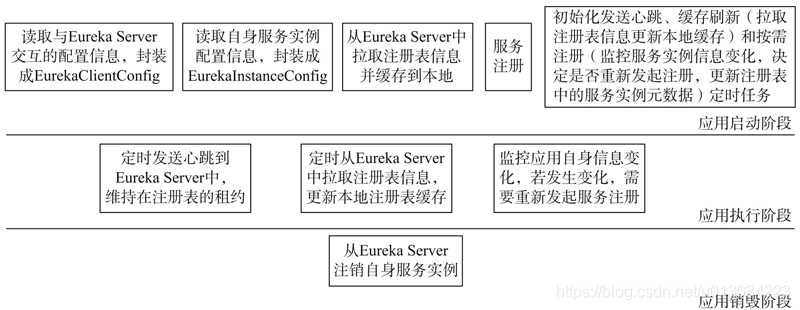【学习背景】
在上一篇文章中,总结了Eureka中的相关组件与行为,也是分析其原理的第一步。本篇文章,先从Eureka Client源代码出发,了解其中的原理。
【学习内容】
先看下图,分阶段地展示了Eureka Client需要完成的工作:

在上图中,像
1. 注册服务实例到Eureka Server中;
2. 发送心跳更新与Eureka Server的租约;
3. 在服务关闭时从Eureka Server中取消租约,服务下线;
4. 查询在Eureka Server中注册的服务实例列表;
这几个核心功能,都是通过DiscoveryClient完成的,DiscoveryClient类是Eureka Client的核心类,相关类图如下:

在DiscoveryClient构造函数中,Eureka Client会执行从Eureka Server中拉取注册表信息、服务注册、初始化发送心跳、缓存刷新(重新拉取注册表信息)和按需注册定时任务等操作,可以说DiscoveryClient的构造函数贯穿了Eureka Client启动阶段的各项工作。其构造函数传入的参数如下:
//DiscoveryClient.java
DiscoveryClient(ApplicationInfoManager applicationInfoManager, EurekaClientConfig
config, AbstractDiscoveryClientOptionalArgs args, Provider<BackupRegistry>
backupRegistryProvider)
ApplicationInfoManager是应用信息管理器,EurekaClientConfig是封装了Client与Server交互配置信息的类。
AbstractDiscoveryClientOptionalArgs是用于注入一些可选参数,以及一些jersey1和jersey2通用的过滤器。
BackupRegistry充当了备份注册中心的职责,当Eureka Client无法从任何一个Eureka Server中获取注册表信息时,BackupRegistry将被调用以获取注册表信息。默认的实现是NotImplementedRegistryImpl,即没有实现。
接着定义一个基于线程池的定时器线程池ScheduledExecutorService,线程池大小为2,一个线程用于发送心跳,另一个线程用于缓存刷新,代码如下:
//DiscoveryClient.java
scheduler = Executors.newScheduledThreadPool(2, new ThreadFactoryBuilder()
.setNameFormat("DiscoveryClient-%d").setDaemon(true).build());
heartbeatExecutor = new ThreadPoolExecutor(...);
cacheRefreshExecutor = new ThreadPoolExecutor(...);
之后,初始化Eureka Client与Eureka Server进行HTTP交互的Jersey客户端,再接着从Eureka Server中拉取注册表信息,代码如下:
//DiscoveryClient.java
private boolean fetchRegistry(boolean forceFullRegistryFetch){
Stopwatch tracer = FETCH_REGISTRY_TIMER.start();
try {
// 如果增量式拉取被禁止,或者Applications为null,进行全量拉取
Applications applications = getApplications();
if(clientConfig.shouldDisableDelta()
||(! Strings.isNullOrEmpty(clientConfig.getRegistryRefreshSingleVipAddress()))
|| forceFullRegistryFetch
||(applications == null)
||(applications.getRegisteredApplications().size()== 0)
||(applications.getVersion()== -1))
{
...
// 全量拉取注册表信息
getAndStoreFullRegistry();
} else {
// 增量拉取注册表信息
getAndUpdateDelta(applications);
}
// 计算应用集合一致性哈希码
applications.setAppsHashCode(applications.getReconcileHashCode());
// 打印注册表上所有服务实例的总数量
logTotalInstances();
} catch(Throwable e){
return false;
} finally {
if(tracer ! = null){
tracer.stop();
}
}
// 在更新远程实例状态之前推送缓存刷新事件,但是Eureka中并没有提供默认的事件监听器
onCacheRefreshed();
// 基于缓存中被刷新的数据更新远程实例状态
updateInstanceRemoteStatus();
// 注册表拉取成功,返回true
return true;
}
通过将Eureka Server中的注册表信息缓存到本地,就可以就近获取其他服务的相关信息,减少与Eureka Server的网络通信。一般来讲,在Eureka客户端,除了第一次拉取注册表信息(全量拉取),之后的信息拉取都会尝试只进行增量拉取。
拉取完Eureka Server中的注册表信息后,将对服务实例进行注册,代码如下:
// DiscoveryClient.java
if(this.preRegistrationHandler ! = null){
this.preRegistrationHandler.beforeRegistration();
}
if(clientConfig.shouldRegisterWithEureka() && clientConfig.shouldEnforceRegistr
ationAtInit()){
try {
// 发起服务注册
if(! register()){
// 注册失败,抛出异常
throw new IllegalStateException("Registration error at startup. Invalid
server response.");
}
} catch(Throwable th){
throw new IllegalStateException(th);
}
}
initScheduledTasks(); // 初始化定时任务
服务注册后,紧接着是初始化定时任务,其中包含三个定时任务:一个用于向Eureka Server拉取注册表信息刷新本地缓存;一个用于向Eureka Server发送心跳;一个用户进行按需注册的操作。代码如下:
// DiscoveryClient.java
private void initScheduledTasks(){
if(clientConfig.shouldFetchRegistry()){
// 注册表缓存刷新定时器
// 获取配置文件中刷新间隔,默认为30s,可以通过eureka.client.registry-fetch-
interval-seconds进行设置
int registryFetchIntervalSeconds = clientConfig.getRegistryFetchInterval
Seconds();
int expBackOffBound = clientConfig.getCacheRefreshExecutorExponentialBac
kOffBound(); scheduler.schedule(
new TimedSupervisorTask("cacheRefresh", scheduler, cacheRefreshExecutor,
registryFetchIntervalSeconds, TimeUnit.SECONDS, expBackOffBound,
new CacheRefreshThread()
),
registryFetchIntervalSeconds, TimeUnit.SECONDS);
}
if(clientConfig.shouldRegisterWithEureka()){
// 发送心跳定时器,默认30秒发送一次心跳
int renewalIntervalInSecs = instanceInfo.getLeaseInfo().getRenewalIntervalInSecs();
int expBackOffBound = clientConfig.getHeartbeatExecutorExponentialBackOff
Bound();
// 心跳定时器
scheduler.schedule(
new TimedSupervisorTask("heartbeat", scheduler, heartbeatExecutor,
renewalIntervalInSecs,
TimeUnit.SECONDS, expBackOffBound, new HeartbeatThread()
),
renewalIntervalInSecs, TimeUnit.SECONDS);
// 按需注册定时器
...
}
对于服务下线,一般情况下,应用服务在关闭的时候,Eureka Client会主动向Eureka Server注销自身在注册表中的信息。DiscoveryClient中对象销毁前执行的清理方法如下所示:
// DiscoveryClient.java
@PreDestroy
@Override
public synchronized void shutdown(){
// 同步方法
if(isShutdown.compareAndSet(false, true)){
// 原子操作,确保只会执行一次
if(statusChangeListener ! = null && applicationInfoManager ! = null){
// 注销状态监听器
applicationInfoManager.unregisterStatusChangeListener(statusChangeListener.getId());
}
// 取消定时任务
cancelScheduledTasks();
if(applicationInfoManager ! = null && clientConfig.shouldRegisterWithEureka()){
// 服务下线
applicationInfoManager.setInstanceStatus(InstanceStatus.DOWN);
unregister();
}
// 关闭Jersy客户端
if(eurekaTransport ! = null){
eurekaTransport.shutdown();
}
// 关闭相关Monitor
heartbeatStalenessMonitor.shutdown();
registryStalenessMonitor.shutdown();
}
}
服务下线方法代码如下:
void unregister(){
// It can be null if shouldRegisterWithEureka == false
if(eurekaTransport ! = null && eurekaTransport.registrationClient ! = null){
try {
EurekaHttpResponse<Void> httpResponse = eurekaTransport.registrationClient.
cancel(instanceInfo.getAppName(), instanceInfo.getId());
} catch(Exception e){
...
}
}
}
【学习总结】
以上就是Eureka Client工作的核心内容及相关源代码。
最后总结一下,主要依次做了以下的事情:
1)相关配置的赋值,类似ApplicationInfoManager、EurekaClientConfig等。
2)备份注册中心的初始化,默认没有实现。
3)拉取Eureka Server注册表中的信息。
4)注册前的预处理。
5)向Eureka Server注册自身。
6)初始化心跳定时任务、缓存刷新和按需注册等定时任务。
这也是Eureka Client核心类DiscoveryClient构造函数中所做的事情。